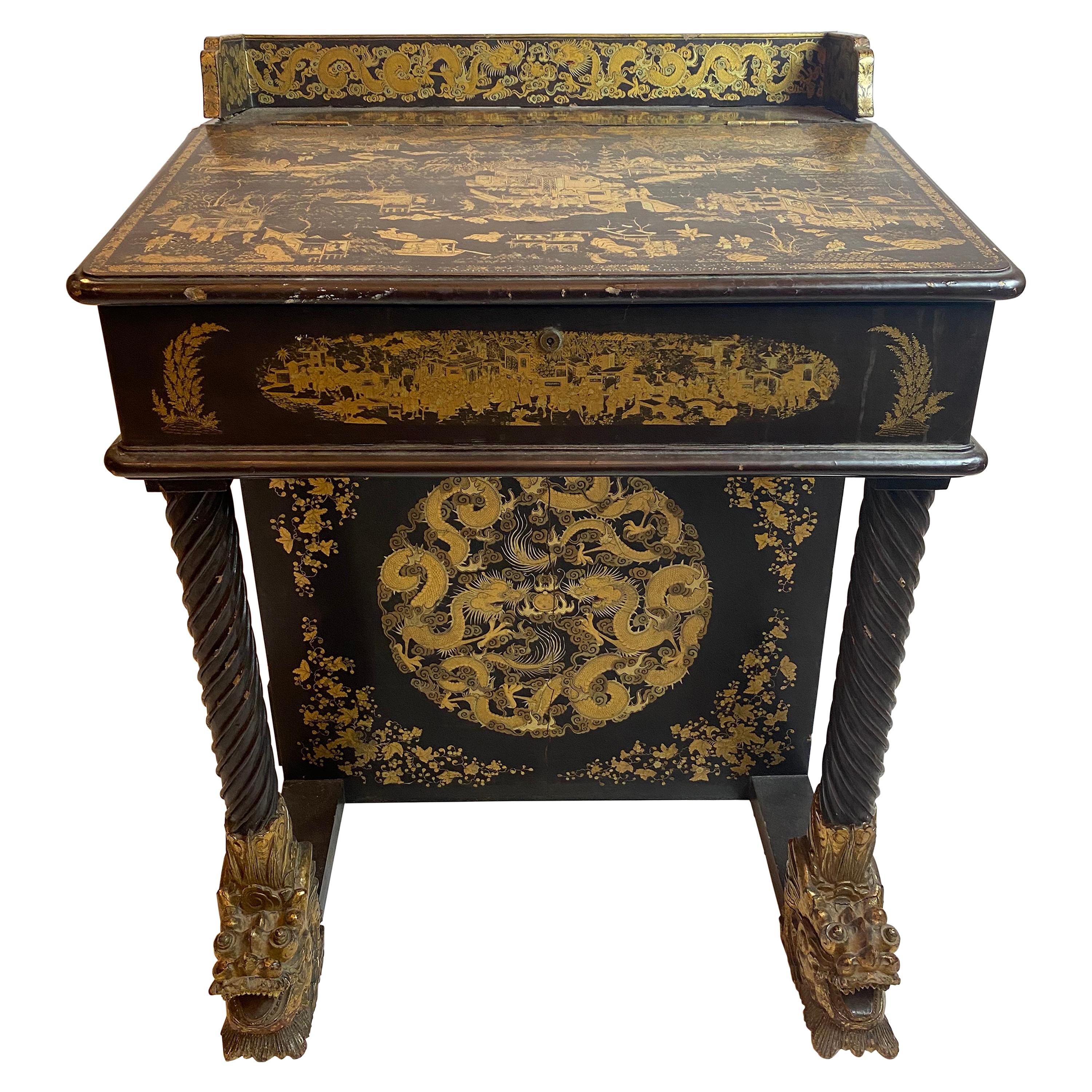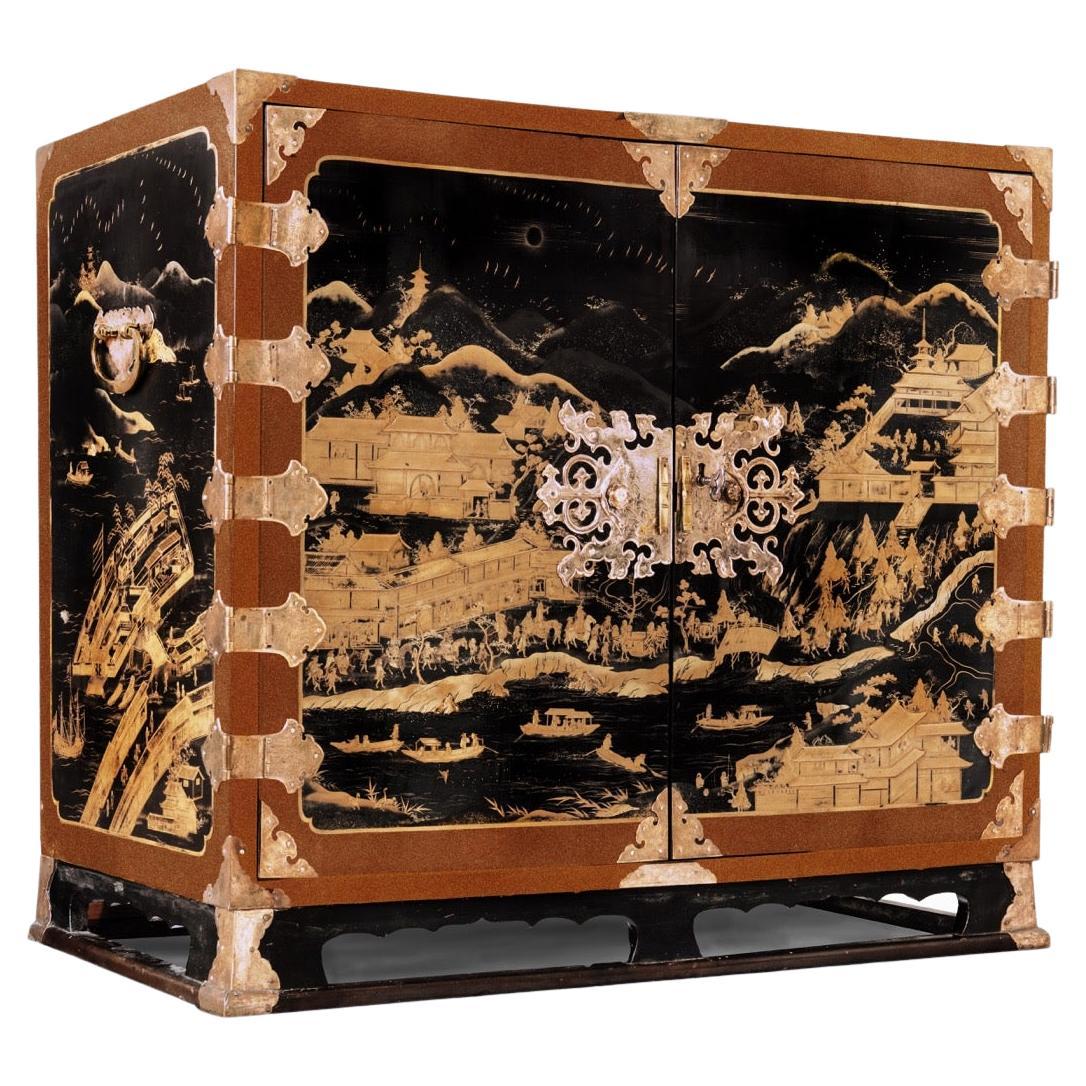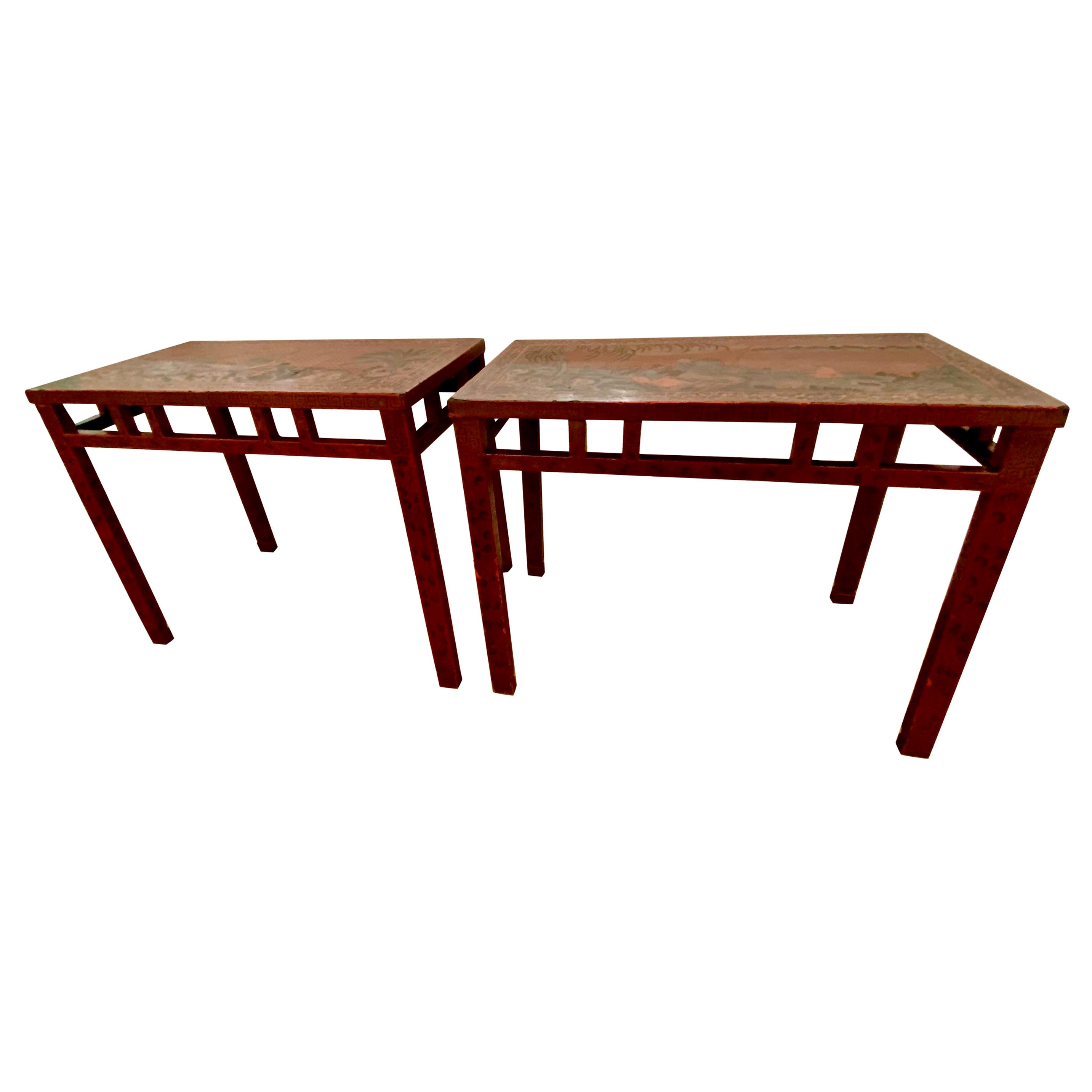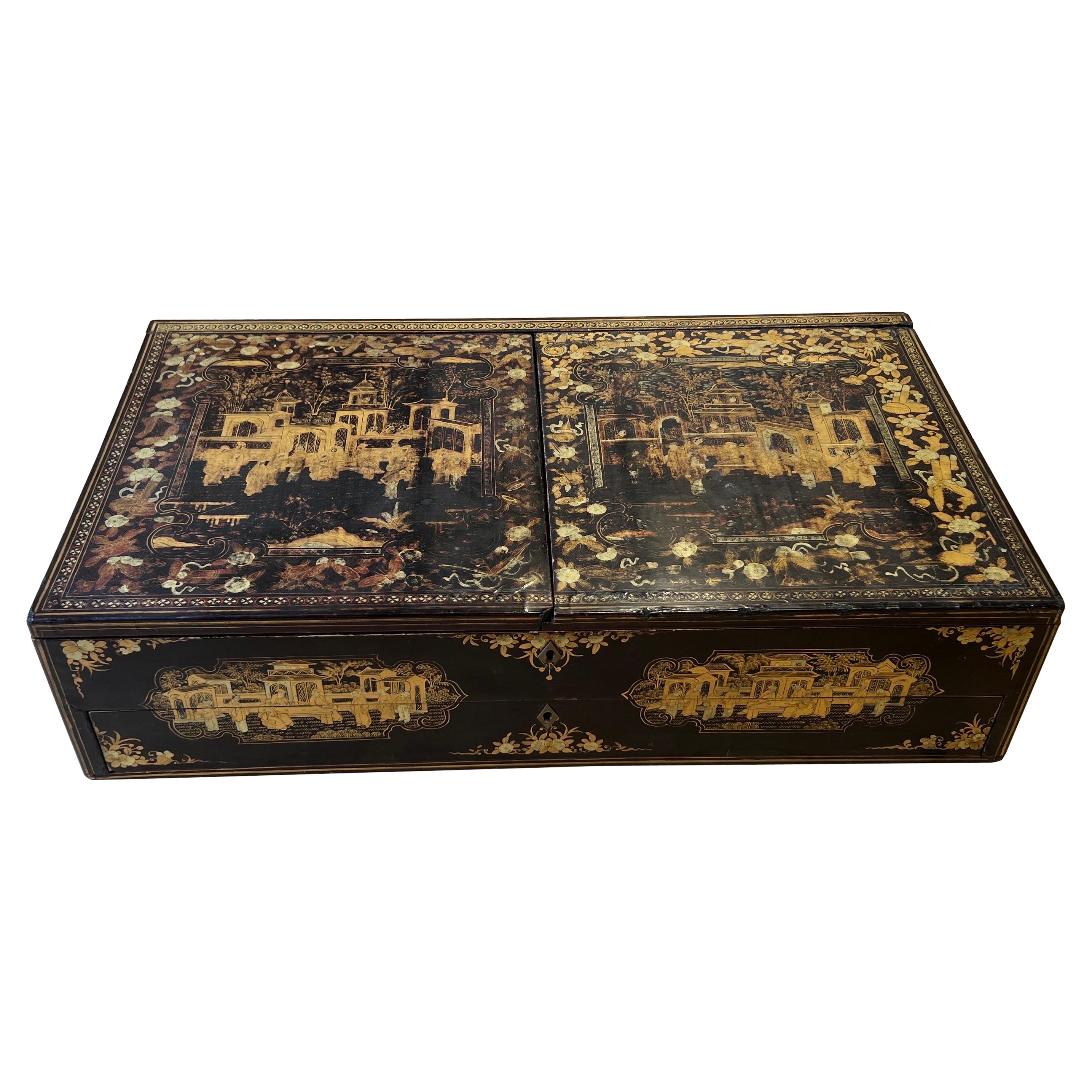Items Similar to 18th Century Chinese Export Lacquer Chinoiserie Bureau Desk for the Dutch Market
Want more images or videos?
Request additional images or videos from the seller
1 of 7
18th Century Chinese Export Lacquer Chinoiserie Bureau Desk for the Dutch Market
About the Item
An extremely rare, possibly unique, Chinese export lacquer bureau for the Dutch market
Canton, circa 1737
H. 118 x W. 102.5 x D. 63 cm
Provenance:
- Private collection, The Netherlands
- J.K. Driessen Antiques, Arnhem (Art Fair Breda, 1989)
- Noble collection, Belgium
Literature:
- C.J.A. Jörg, ’De handel van de V.O.C. in Oosters lakwerk in de 18de eeuw’ in: Nederlands Kunsthistorisch Jaarboek , Jr. 31 (1980), pp. 355-363 (ill.)
- Annigje Hofstede, Nederlandse meubelen van Barok tot Biedermeier, 1700-1830, Waanders, Zwolle 2004, pp. 35-37 (ill.)
This lacquer bureau is one of the four writing desks purchased in Canton in 1737, and as far as is known, this is the only remaining bureau of its type from the period. As the VOC believed that large pieces of import took up too much valuable space in their trading ships, few Chinese furniture pieces were crafted for the Dutch market. Even fewer have survived the test of time.
After 1693, Japanese lacquerware can no longer be found in the VOC books, probably because it had become too costly for import. European fashion and the production of unique imitation lacquer must have also contributed to the halt of its import. The demand, however, remained high. In 1730, the Lords XVII, the directors of the VOC, sent several models of Japanese lacquerware to Batavia with the question if it could be produced for a lower price in China. After 1729, a direct sailing route was used from the Netherlands to Canton, and the trade no longer went through Batavia.
?The Middelburg chamber of the VOC auctioned off a large quantity of tea trays made of Chinese lacquer in 1734, which was a great success resulting in more orders. In 1737, two shipments of lacquer trays were ordered: one for Amsterdam and one for Middelburg. Each city received three boxes with the same content. The first shipment box also contained a ‘cabinet’ or ‘writing office’, and in it had been packed a table-top (without a foot element) in the lower drawer, 5 trays in the second drawer, 15 elongated trays; in the third drawer 45 elongated tea trays, 5 sets of 5 pieces of powder boxes and so on. Space was costly, so each drawer was packed with smaller lacquer pieces. The second box had the same contents, and the third one was filled with 500 serving trays and 500 teacups. In 1738, this assortment of lacquer was sold at auction. The pieces of furniture were an exception to the orders, and the purchase lists reveal that cabinets were no longer ordered in the following years.
This writing desk was made after a Dutch example, and it was crafted especially for the Dutch market rather than to the taste of English buyers, as is made clear by its slightly organ-curved front. From 1730, these fall-front bureaus were quite popular in The Netherlands, often featuring diagonally positioned side stiles. This export lacquer bureau is exceptionally well-preserved with its original brass handles and lock escutcheon.
Decorated throughout with gilt landscapes and floral details on a black lacquer background. The drawers, fall front and side panels are richly adorned with images of Chinese pavilions surrounded by pine trees and weeping willows. The desk's interior comprises twelve drawers with floral decor and two standing fluted drawers trimmed with capitals and basements. The centre features a cupboard door with a decoration of a vase filled with flowers, a symbol of peace and tranquillity in China. The interiors of the drawers are finished with gold powder lacquer. All drawers are inscribed with a Chinese character. The desk also contains a storage compartment, which opens with a sliding panel (in French à coulisse, and a keldertje in Dutch). Beneath the fall front are four drawers flanked by fluted and gilded stiles. The Chinese cabinet maker has followed his own interpretation of the claw-and-ball feet motifs, which feature taotie masks above them. This motif of an animal mask dates back thousands of years and can be found on Chinese bronzes from the dawn of civilisation. The bureau’s manner of construction is quite interesting and is carried out in Cypresswood, which differs from the wood used by European craftsmen. The joints of the drawers are not forked as they usually are in Europe but are somewhat rectangular in shape.
- Dimensions:Height: 46.46 in (118 cm)Width: 40.36 in (102.5 cm)Depth: 24.81 in (63 cm)
- Style:Chinese Export (Of the Period)
- Materials and Techniques:
- Place of Origin:
- Period:
- Date of Manufacture:circa 1737
- Condition:Wear consistent with age and use.
- Seller Location:Amsterdam, NL
- Reference Number:1stDibs: LU5458234423832
About the Seller
5.0
Vetted Seller
These experienced sellers undergo a comprehensive evaluation by our team of in-house experts.
Established in 1985
1stDibs seller since 2020
19 sales on 1stDibs
Typical response time: 3 hours
- ShippingRetrieving quote...Ships From: Amsterdam, Netherlands
- Return PolicyA return for this item may be initiated within 7 days of delivery.
More From This SellerView All
- 17th Century Japanese Export Lacquer Cabinet with Depiction the Dutch TradepostLocated in Amsterdam, NLA highly important Japanese export lacquer cabinet with depiction of the Dutch East India Company tradepost Deshima and the annual Dutch delegation on its way to the Shogun in Edo Edo period, circa 1660-1680 H. 88 x W. 100.5 x D. 54 cm This cabinet includes a later European japanned stand, but also a modern powder-coated steel frame. The latter can be designed and added to your specific needs. The sides and front of the rectangular two-door cabinet are embellished in gold and silver hiramaki-e and takamaki-e on a black roiro lacquer ground with a continuous design. The two doors depict a long procession of numerous figures travelling on foot and horseback along buildings and a pagoda into a mountainous landscape. This is the annual court journey, Hofreis, of the Dutch from Nagasaki to the Shogun’s court in Edo. Three horseback riders are dressed as Dutch merchants and a fourth figure, probably het Opperhoofd, is seen inside a palanquin, norimon. Just about to cross the bridge, two men are carrying a cabinet like the present one. Many Japanese figures on either side of the procession are engaged in various activities; some play musical instruments on board of small boats, others are fishing; figures inside buildings are depicted playing go, and farmers are tending to their rice paddocks. The upper part of the right door shows a large mansion, probably the local daimyo’s castle, with men kneeling before a man in the central courtyard. The court journey fits in with the foreign policy of the shogunate which accorded a role to the VOC alongside China, Korea, and the Ryukyu Islands who also had to pay tribute. However, the VOC employees were traders, having low status in Japan’s social hierarchy, and they were received with less deference than were the state embassies from Korea and the Ryukyu Islands. Nevertheless, the contacts with the Dutch were a welcome source of information to the Shogun about Europe and European science and technology. The left side of the cabinet depicts, in mirror image, a rare view of the artificial fan-shaped Deshima Island, the trading post for the Dutch in Japan. The island, where the Dutch flag flies, is surrounded by small Japanese boats and an anchored three-masted fluyt (cargo ship), flying Dutch flags, with on the stern the VOC monogram. On the bottom right a busy street of Nagasaki is shown, bordered by shops and leading up to the stone bridge. On the island the trees are beautifully painted, two cows can be seen, and the flagpole, all in very fine detail. Dutchmen and enslaved Malay are visible outside the buildings and two Japanese figures, probably guards, sit in a small hut in the centre. A maximum of fifteen to twenty Dutchmen lived on the island at any time and soldiers or women were not allowed. Restrictions on Deshima were tight, and the merchants were only allowed to leave the island by special permission. The Opperhoofd had to be replaced every year, and each new Opperhoofd had to make a court journey to pay tribute, present gifts, and to obtain permission to Margaret Barclay eep on trading. In the distance, many birds fly above the hills and a four-story pagoda can be seen. The right side of the cabinet is painted with other horse riders and their retinue journeying through mountains. The pair of doors to the front open to reveal ten rectangular drawers. The drawers are decorated with scenes of birds in flight and landscapes with trees and plants. The reverse of the left door with two thatched buildings, one with a ladder, underneath a camelia tree with large blooms; the right door with a three-story pagoda nestled among trees and both doors with a flying phoenix, ho-oo bird. The cabinet, with elaborately engraved gilt copper mounts, hinges, lock plates and brass handles, is raised on an 18th-century English japanned wood stand. A pair of large cabinets...Category
Antique 17th Century Japanese Edo Lacquer
MaterialsCopper, Gold
- Rare Charming 17th Century Japanese Lacquer Cabinet with Gilt-Bronze MountsLocated in Amsterdam, NLA fine Japanese pictoral style lacquer cabinet with gilt-metal mounts Kyoto, Edo period, 1670-1690 Decorated in Japanese relief lacquer work, black lacquer ground decorated...Category
Antique Late 17th Century Japanese Furniture
MaterialsBronze
- Pair of Fine Japanese Export Lacquer Cutlery Knife Boxes, 18th CenturyLocated in Amsterdam, NLA pair of fine Japanese export lacquered cutlery boxes Kyoto or Nagasaki, late 18th century H. 33.5 x W. 24 x D. 21 cm The bow-fronted boxes with sloping lids flat at the top are made of hinoki wood (Cypress), coated with Japanese paper and decorated in lacquer with scattered gold birds and flowers on a nashiji background. The Japanese mounts are made of copper and both boxes still have internal partitions to keep the cutlery upright. The form of these boxes is similar to a pictorial-style knife box in the collection of the Groninger Museum (inv. 1989- 347), dated between 1730 and 1780, but the style of the decoration is more like that on a knife box in the Peabody Essex Museum in Salem (inv. E62271), which was brought to Salem by James Devereux, Captain of the Franklin, in 1799. Provenance: Henriette Jeane Christine van Neukirchen, called Nyvenheim (1807- 1849) and Nicolaas Johan Steengracht van Oostcapelle (1806-1866), thence by descent to the last owners, Ludolphine Emilie baronesse Schimmelpenninck van der Oye (1944) married in 1969 to Roland Daniel van Haersma Buma (1944), the last residents of castle Duivenvoorden near Voorschoten and the great-great-granddaughter of Nicolaas Johan Steengracht van Oostcapelle. There is no evidence that Nicolaas Johan himself, or any of his or his wife’s ancestors had ever been in Japan. However, Nicolaas’ grandfather (Nicolaas Steengracht, 1754-1840) was a director of both the VOC and WIC (West Indies Company...Category
Antique Late 18th Century Japanese Lacquer
MaterialsSilver
- Two 18th Century Lacquered Wood Chinese Yoke-Back Chairs, Chinoiserie ChiqueLocated in Amsterdam, NLA pair of lacquered wood northern Chinese yoke-back chairs, Guan mao shi Hebei Province, Qing Dynasty, early 18th century Measures: H. 99.5 x W. 61 x D. 49 cm ?The back spla...Category
Antique Early 18th Century Chinese Qing Furniture
MaterialsWood
- Japanese Export Lacquer Mother-of-Pearl Secretaire for the American MarketLocated in Amsterdam, NLA rare Japanese export lacquered secretaire for the American market Circa 1800-1830, Colonial Overall densely decorated with flower sprays and landscapes, minutely inlaid with ...Category
Antique 1810s Japanese Edo Furniture
MaterialsMother-of-Pearl, Wood
- Dutch-Colonial 18th Century Small Children's or Ladies Bureau with Silver MountsLocated in Amsterdam, NLA Dutch-colonial Indonesian small Albizia adoratissima, Nangka and Ambalo wood Lady’s tambour bureau with silver mounts Batavia (Jakarta) or Palembang, late 18th century H. 129.5 x W. 70 x D. 39 cm The tambour desk or bureau a` cilindre came into fashion in the Dutch East Indies of the late 18th century, when French forms prevailed in the Netherlands. The carvings on the apron and the stiles on the sides and at the top of the central stile are typical Indonesian designs. This small piece of furniture is not a miniature but was probably used as a regular bureau-cabinet by colonial society women of Indonesian-European descent. They usually are smaller than European women and often didn’t use chairs but sat or kneeled, and even slept on the floor for coolness. Earlier that century Dutch-colonial Indonesian and Cape Dutch...Category
Antique 18th Century Indonesian Dutch Colonial Children's Furniture
MaterialsWood
You May Also Like
- 19th Century Chinese Export Lacquer and Gilt Davenport DeskLocated in Brea, CAEarly 19th century Chinese export lacquer and gilt Davenport desk, the entire finely decorated with the typical figural landscape and foliate gilt decoration, the sloped top opening ...Category
Antique Early 19th Century Chinese Qing Lacquer
MaterialsLacquer
- Chinese Altar Tables, 19th C. LacquerLocated in Pasadena, CAThis is an unusual pair of Late Ching Chinese cinnabar-toned coromandel lacquer small altar or side tables. The tops of the tables feature complementary incised and painted scenes from Chinese every day life. Both tables are in very good condition considering their 100+ years of use. It is unusual to find a pair of coromandel incised lacquer...Category
Antique Mid-19th Century Chinese Chinese Export Lacquer
MaterialsWood, Lacquer
- Antique 18th Century Export Chinese Lacquer Gaming BoxLocated in Brea, CAAntique 18th century export Chinese lacquer gaming box with hand painted scenes gilt export black lacquer, there are 7 gaming boxes and 12 trays, size: ...Category
Antique Late 18th Century Chinese Qing Lacquer
MaterialsLacquer
- Exceptional Chinese Export Gilt Black Lacquer Chinoiserie Decorated Lap DeskLocated in Atlanta, GAChinese export, circa 1820. An exceptional quality and rare form. Featuring figural landscape decorations in gilt to the main black lacquer doors, which open to reveal 13 separated c...Category
Antique Early 19th Century Chinese Chinese Export Lacquer
MaterialsGiltwood, Lacquer
- XX°Century Chinese Decorative Screen Lacquered whit Landscape and SailsLocated in Brescia, ITChinese screen in black lacquered wood decorated with gilded paintings, very sturdy with excellent wooden base.Category
20th Century Chinese Chinese Export Furniture
MaterialsGiltwood, Lacquer, Wood
- Antique Japanese Export Lacquer Bamboo Stick StandLocated in Brea, CAAntique Japanese export lacquer and gilt bamboo stick stand, see more pictures, 46'' x 27.5'' x 10''.Category
Early 20th Century Japanese Meiji Lacquer
MaterialsBamboo
Recently Viewed
View AllMore Ways To Browse
Chinese Brass Serving Tray
Set Of Twelve Antique French Interior
Door Handel
Antique Japanese Teacup
Chinese Lacquer Serving Tray
Biedermeier China Cabinet
Chinese Lacquer Bureau
Antique Chinese Writing Bureau
Claw Foot Writing Table
1700 French Bureau
Antique Chinese Brass Tray Table
Writing Desk Ball Foot
Chinese Export Bureau
Ball And Claw Foot Desk
Black And Gold Chinese Desk
Dutch Cabinets Asia
Gold Lacquer Tea Box
Antique Japanese Tea Cabinet





